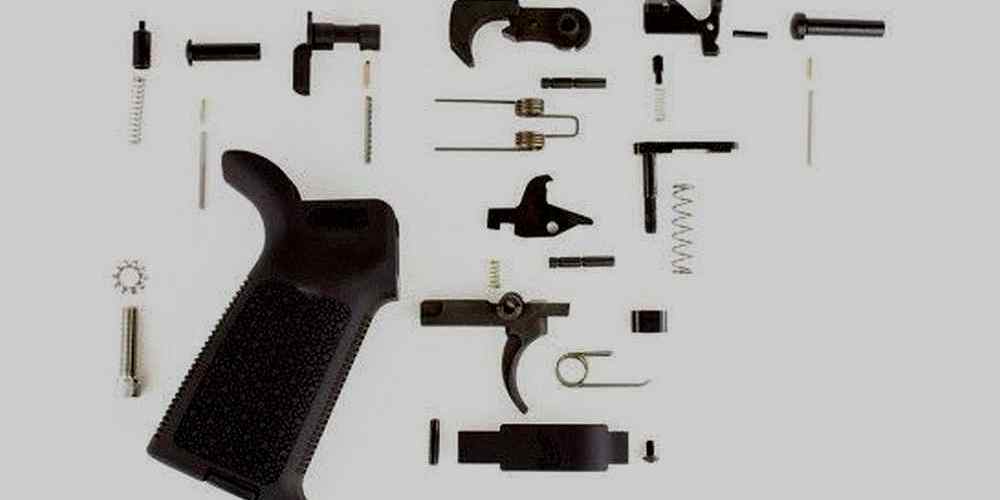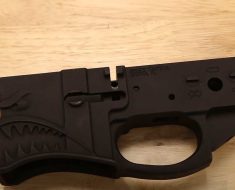“Find the perfect balance with our 80% AR15 lower receivers.”
Stripped AR15 Lower: Pros and Cons
When it comes to building your own AR15 rifle, one of the first decisions you’ll need to make is whether to start with a stripped lower receiver, a complete lower receiver, or an 80% lower receiver. Each option has its own set of pros and cons, so it’s important to understand the differences before making your choice.
Let’s start by looking at stripped AR15 lower receivers. These are essentially just the lower receiver itself, with no additional parts or components. The main advantage of starting with a stripped lower is that it allows you to customize your rifle exactly the way you want it. You can choose your own trigger, grip, stock, and other components to create a rifle that is tailored to your preferences.
However, the downside of a stripped lower is that it requires more time, effort, and knowledge to assemble. You’ll need to purchase all of the necessary parts separately and then put them together yourself. This can be a fun and rewarding process for those who enjoy building their own firearms, but it can also be intimidating for beginners or those who are not mechanically inclined.
Another consideration with stripped lowers is that they are subject to more regulations than complete lowers. In some states, stripped lowers are considered firearms and must be purchased through a licensed dealer, whereas complete lowers are not subject to the same restrictions. This can make it more difficult to acquire a stripped lower, depending on where you live.
Despite these drawbacks, many gun enthusiasts prefer stripped lowers for the flexibility and customization they offer. If you enjoy tinkering with firearms and want to build a rifle that is truly unique to you, a stripped lower may be the way to go.
Next, let’s take a look at complete AR15 lower receivers. These come fully assembled with all of the necessary parts, including the trigger, grip, stock, and buffer tube. The main advantage of a complete lower is that it is ready to go right out of the box. You simply attach it to your upper receiver, and you’re ready to hit the range.
The downside of a complete lower is that it offers less customization options than a stripped lower. You are limited to the components that come pre-installed, so if you have specific preferences for things like trigger pull weight or stock length, you may need to swap out some parts. Additionally, complete lowers tend to be more expensive than stripped lowers, as you are paying for the convenience of having everything already assembled.
Despite these limitations, complete lowers are a popular choice for those who want a straightforward and hassle-free build. If you’re new to building AR15 rifles or simply want a rifle that is ready to go with minimal effort, a complete lower may be the best option for you.

Finally, let’s consider 80% AR15 lower receivers. These are partially completed lower receivers that require some additional machining to be considered a firearm. The main advantage of an 80% lower is that it allows you to build a rifle from scratch while avoiding some of the regulations that apply to fully completed lowers.
However, the downside of an 80% lower is that it requires more time, effort, and specialized tools to complete. You’ll need to carefully follow instructions and use a drill press or milling machine to finish the remaining 20% of the lower receiver. This can be a challenging and time-consuming process, especially for those who are new to gunsmithing.
Despite these challenges, many gun enthusiasts enjoy the sense of accomplishment that comes with completing an 80% lower. If you’re looking for a hands-on project and want to build a rifle that is truly your own creation, an 80% lower may be the right choice for you.
In conclusion, the best AR15 lower receiver for you will depend on your level of experience, your preferences for customization, and your willingness to put in the time and effort required for assembly. Stripped lowers offer the most flexibility but require more work, complete lowers are convenient but offer less customization, and 80% lowers provide a hands-on building experience but require additional machining. Consider your priorities and choose the option that best fits your needs and preferences.
Complete AR15 Lower: What You Need to Know
When it comes to building your own AR15 rifle, one of the most important decisions you’ll need to make is which lower receiver to choose. The lower receiver is the part of the rifle that houses the trigger group, magazine well, and buffer tube, making it a crucial component in the overall functionality of the firearm. There are three main options to consider when selecting a lower receiver: complete, stripped, or 80% lower. In this article, we’ll focus on the complete AR15 lower and what you need to know before making your purchase.
A complete AR15 lower is exactly what it sounds like – a lower receiver that comes fully assembled with all the necessary components. This option is ideal for those who are new to building rifles or simply want a hassle-free experience. With a complete lower, you won’t have to worry about sourcing individual parts or putting them together yourself. Everything is already installed and ready to go, making it a great option for beginners or those who prefer a more straightforward approach.
One of the main advantages of a complete AR15 lower is that it saves you time and effort. Instead of spending hours researching and purchasing individual parts, you can simply buy a complete lower and be ready to assemble the rest of your rifle. This can be especially beneficial for those who are new to building firearms and may not have the knowledge or experience to confidently select and install each component.
Another benefit of a complete AR15 lower is that it ensures compatibility and functionality. Since all the parts are pre-assembled by the manufacturer, you can trust that they will work together seamlessly. This can help prevent any issues or malfunctions that may arise from mismatched or improperly installed components. Additionally, many complete lowers come with a warranty or guarantee, giving you peace of mind knowing that your investment is protected.
When choosing a complete AR15 lower, there are a few key factors to consider. First, you’ll want to make sure that the lower is made from high-quality materials, such as aluminum or polymer. This will ensure durability and longevity, as well as provide a solid foundation for your rifle. Additionally, you’ll want to consider the manufacturer’s reputation and customer reviews to ensure that you’re getting a reliable product.
In conclusion, a complete AR15 lower is a great option for those who want a hassle-free and reliable building experience. With all the necessary components pre-assembled and ready to go, you can save time and effort while ensuring compatibility and functionality. Just be sure to choose a high-quality lower from a reputable manufacturer to ensure a successful build.
80% AR15 Lower: A Beginner’s Guide
If you’re new to the world of AR15s, you may have heard about 80% lower receivers and wondered what they are all about. In this beginner’s guide, we’ll break down everything you need to know about 80% AR15 lowers and help you decide if they are the right choice for you.
First off, what exactly is an 80% lower receiver? An 80% lower is a partially completed lower receiver for an AR15 that requires some additional machining in order to be fully functional. This means that it is not considered a firearm by the ATF until it has been completed by the end user. This can be an appealing option for those who want to build their own AR15 from scratch and have the satisfaction of knowing they did it themselves.
One of the main benefits of using an 80% lower is that it allows for more customization and personalization than a stripped lower receiver. With an 80% lower, you have the freedom to choose your own finish, engraving, and other details that can make your AR15 truly unique. This can be a fun and rewarding project for those who enjoy working with their hands and want to create a one-of-a-kind firearm.
Another advantage of using an 80% lower is that it can be a more cost-effective option than purchasing a complete lower receiver. While you will need to invest in some additional tools and equipment in order to complete the machining process, the overall cost can still be lower than buying a pre-made lower. This can be a great option for those who are on a budget but still want to build their own AR15.
However, it’s important to keep in mind that completing an 80% lower does require some technical skill and knowledge. You will need access to a drill press or milling machine, as well as the ability to follow detailed instructions and measurements. If you are new to firearms or machining, it may be a good idea to seek out some guidance or assistance from someone with more experience.
In addition, it’s worth noting that completing an 80% lower can be a time-consuming process. It requires patience and attention to detail in order to ensure that the final product is safe and functional. If you are looking for a quick and easy way to build an AR15, a complete lower receiver may be a better option for you.
Overall, 80% lower receivers can be a great choice for those who are looking for a hands-on project and want to customize their AR15 to their own specifications. With the right tools and knowledge, completing an 80% lower can be a rewarding experience that results in a firearm that is truly your own. Just remember to take your time, follow instructions carefully, and prioritize safety throughout the process.
Choosing the Right AR15 Lower for Your Build
When it comes to building your own AR15, one of the most important decisions you’ll need to make is choosing the right lower receiver. The lower receiver is the part of the rifle that houses the trigger group, magazine well, and pistol grip, and it plays a crucial role in the overall function and performance of your firearm. There are three main types of AR15 lower receivers to choose from: stripped, complete, and 80%. Each type has its own set of advantages and disadvantages, so it’s important to understand the differences between them before making your decision.
Let’s start with stripped lower receivers. As the name suggests, stripped lowers come without any of the internal components installed. This means that you’ll need to purchase and install all of the necessary parts yourself, including the trigger group, buffer tube, and stock. While this may sound like a daunting task for beginners, it can actually be a great option for those who want complete control over every aspect of their build. Stripped lowers also tend to be more affordable than complete lowers, making them a popular choice for budget-conscious builders.
On the other hand, complete lower receivers come fully assembled with all of the internal components already installed. This makes them a much simpler option for those who are new to building AR15s or who simply don’t want to deal with the hassle of installing individual parts. Complete lowers are also a great choice for those who want to ensure that all of the components are properly matched and compatible with each other. However, this convenience does come at a cost, as complete lowers are typically more expensive than stripped lowers.
Finally, there are 80% lower receivers, which are partially completed lower receivers that require some machining in order to be fully functional. While this may sound intimidating, 80% lowers are actually a popular choice for experienced builders who want to customize their build even further. By completing the remaining 20% of the lower receiver themselves, builders can create a truly unique firearm that meets their exact specifications. However, it’s important to note that 80% lowers require a certain level of skill and equipment to complete, so they may not be the best option for beginners.
So, which type of AR15 lower receiver is right for you? Ultimately, the answer will depend on your level of experience, budget, and personal preferences. If you’re a beginner or on a tight budget, a stripped lower receiver may be the best option for you. If you value convenience and ease of assembly, a complete lower receiver may be the way to go. And if you’re an experienced builder looking for a challenge, an 80% lower receiver could be the perfect choice.
No matter which type of lower receiver you choose, it’s important to do your research and make sure that you’re purchasing a high-quality product from a reputable manufacturer. The lower receiver is the foundation of your AR15 build, so it’s crucial to invest in a reliable and durable component that will stand the test of time. With the right lower receiver and a little bit of know-how, you’ll be well on your way to building the AR15 of your dreams.
Comparing Stripped, Complete, and 80% AR15 Lowers
When it comes to building your own AR15 rifle, one of the first decisions you’ll need to make is what type of lower receiver to use. There are three main options to choose from: stripped, complete, and 80%. Each has its own set of pros and cons, so it’s important to understand the differences between them before making a decision.
Let’s start with stripped lowers. These are the most basic option and come without any of the internal components installed. This means that you’ll need to purchase all of the necessary parts separately and assemble them yourself. While this may sound daunting to some, it can actually be a great way to learn more about how your rifle works and gain a deeper understanding of its inner workings. Stripped lowers also tend to be the most affordable option, making them a popular choice for budget-conscious builders.
On the other end of the spectrum are complete lowers. These come fully assembled with all of the internal components already installed, so all you need to do is attach an upper receiver and you’re ready to go. This can be a great option for those who are new to building rifles or simply don’t want to deal with the hassle of sourcing and assembling individual parts. However, complete lowers tend to be more expensive than stripped lowers, so keep that in mind when making your decision.
Somewhere in between stripped and complete lowers are 80% lowers. These are partially finished lower receivers that require some machining in order to be completed. While this may sound intimidating, it’s actually a relatively straightforward process that can be completed with basic tools and a bit of patience. One of the main advantages of 80% lowers is that they are not considered firearms by the ATF until they have been completed, so they can be shipped directly to your door without the need for a background check. This can be a major selling point for those who value their privacy or simply want to avoid the hassle of dealing with a gun store.
In terms of customization options, stripped lowers offer the most flexibility since you can choose exactly which parts to use and how to assemble them. Complete lowers, on the other hand, come pre-assembled with a specific set of components, so your options for customization may be more limited. 80% lowers fall somewhere in between, as you’ll have to finish them yourself but can still choose which parts to use once they’re completed.
When it comes to cost, stripped lowers are generally the most affordable option, followed by 80% lowers and complete lowers. However, keep in mind that the total cost of your build will depend on the quality of the parts you choose, so it’s important to factor that into your decision-making process.
In conclusion, the right AR15 lower for you will depend on your level of experience, budget, and personal preferences. Stripped lowers offer the most customization options and are the most affordable, while complete lowers are the easiest to assemble but tend to be more expensive. 80% lowers offer a good balance between the two, with the added benefit of being able to ship directly to your door. Whichever option you choose, building your own AR15 can be a rewarding and educational experience that allows you to create a rifle that is truly your own.





